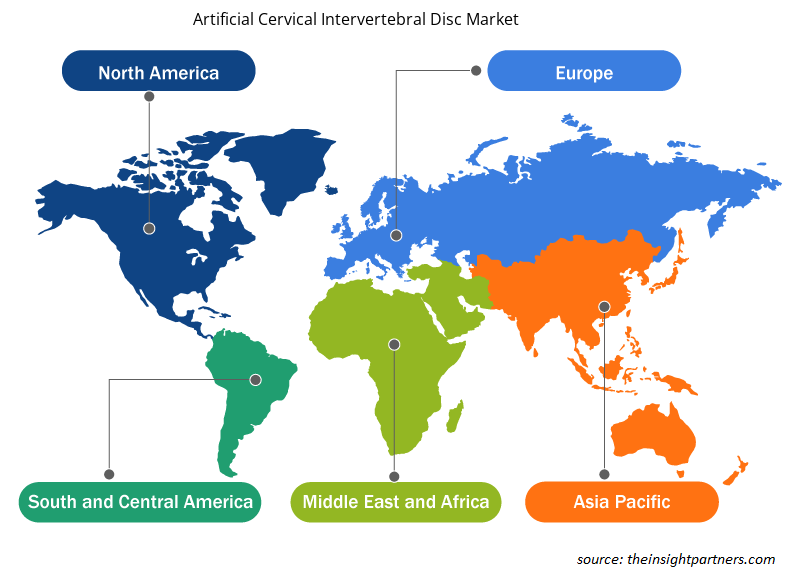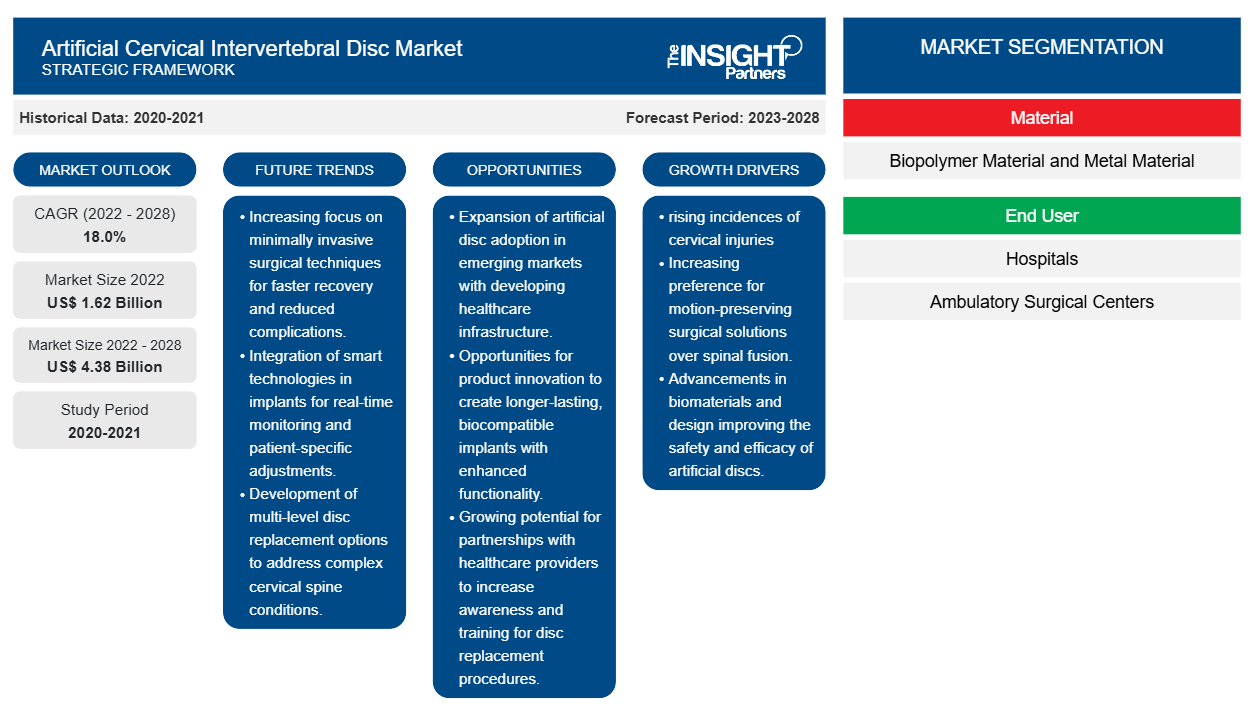[Forschungsbericht] Der Markt für künstliche Halswirbelscheiben soll von 1.621,66 Millionen US-Dollar im Jahr 2022 auf 4.375,29 Millionen US-Dollar im Jahr 2028 wachsen; von 2022 bis 2028 wird mit einer durchschnittlichen jährlichen Wachstumsrate von 18,0 % gerechnet.
Das Wachstum des Marktes für künstliche Halswirbelscheiben wird auf die steigende Prävalenz von Halswirbelverletzungen zurückgeführt. Die Hauptursache für Halswirbelverletzungen sind Traumata, darunter Autounfälle, penetrierende oder stumpfe Traumata, Stürze sowie Sport- oder Tauchverletzungen. Laut der Studie „Estimating the Number of Traffic Crash-Related Cervical Spine Injuries in the US: an Analysis and Comparison of the National Crash and Hospital Data“, die 2020 veröffentlicht wurde, werden in den USA jährlich etwa 869.000 verkehrsunfallbedingte Halswirbelverletzungen in Krankenhäusern beobachtet, davon etwa 841.000 Verstauchungen/Zerrungen (Schleudertrauma), 2.800 Bandscheibenverletzungen, 23.500 Frakturen, 2.800 Rückenmarksverletzungen und 1.500 Luxationen. Darüber hinaus handelt es sich bei den meisten Sportverletzungen um orthopädische Verletzungen, darunter Zerrungen, Verstauchungen, Frakturen, Bänderrisse, Schmerzen und Schwellungen; diese können akut oder chronisch sein. Laut Stanford Children's Health treiben in den USA jährlich etwa 30 Millionen Jugendliche und Kinder Sport, und jedes Jahr werden mehr als 3,5 Millionen sportbedingte Verletzungen gemeldet. Eine Halswirbelfraktur ist die Folge eines Hochenergie-Traumas, wie etwa eines Sturzes beim Turnen, Hockey, Fußball oder Wasserspringen. Die Häufigkeit von Frakturen ist bei Sportlern hoch. Laut „Spinal Cord Injury Facts and Figures at a Glance, 2020“ sind in den USA etwa 7,8 % aller Rückenmarksverletzungen (SCI) auf Sport zurückzuführen. Laut der US-amerikanischen Consumer Product Safety Commission (CPSC) wurden im Jahr 2018 in den Notaufnahmen von US-Krankenhäusern etwa 23.720 Halswirbelfrakturen behandelt; davon waren etwa 3.194 Frakturen auf Sport zurückzuführen. Die Zahl der Sportverletzungen nimmt mit der zunehmenden Teilnahme an Sport und aktiver Teilnahme an Fitnessaktivitäten zu, da weltweit ein gesunder Lebensstil immer mehr im Mittelpunkt steht. Darüber hinaus ist Tauchen laut dem National Spinal Cord Injury Statistical Center die fünfthäufigste Ursache für schwere Verletzungen des Halswirbels. Daher steigt die Nachfrage nach künstlichen Bandscheiben für die Halswirbelsäule aufgrund der steigenden Zahl von Verletzungen der Halswirbelsäule.
Die Bandscheibe kann eine enorme Druckbelastung absorbieren und gleichzeitig verschiedene Arten von Bewegungen zwischen den Knochen im Nackenbereich ermöglichen. Marktteilnehmer haben mehrere künstliche Bandscheiben für die Halswirbelsäule entwickelt, die zur Behandlung von Bandscheibenproblemen eingesetzt werden. Künstliche Bandscheiben ersetzen die Bewegungs- und Dämpfungsfunktion beschädigter Bandscheiben.
Passen Sie diesen Bericht Ihren Anforderungen an
Sie erhalten kostenlos individuelle Anpassungen an jedem Bericht, einschließlich Teilen dieses Berichts oder einer Analyse auf Länderebene, eines Excel-Datenpakets sowie tolle Angebote und Rabatte für Start-ups und Universitäten.
-
Holen Sie sich die wichtigsten Markttrends aus diesem Bericht.Dieses KOSTENLOSE Beispiel umfasst eine Datenanalyse von Markttrends bis hin zu Schätzungen und Prognosen.
Markteinblicke
Steigende geriatrische Bevölkerung treibt den Markt für künstliche Bandscheiben an
Der Alterungsprozess wirkt sich auf die Halswirbelsäule, den Nacken, die Schultern, den oberen Rücken und die Arme aus. Zervikale Spondylose ist ein Begriff für altersbedingte Abnutzung der Bandscheiben im Nacken. Es ist eine häufige Krankheit und verschlimmert sich mit dem Alter. Laut der American Academy of Orthopaedic Surgeons sind etwa 85 % der Menschen über 60 von zervikaler Spondylose betroffen. Mit zunehmendem Alter trocknen die Bandscheiben, die als Stoßdämpfer dienen, allmählich aus und ihre Festigkeit nimmt ab. Laut dem Fact Sheet: Aging in the United States wird die Zahl der Personen im Alter von 65 Jahren und älter in den Vereinigten Staaten von schätzungsweise 52 Millionen im Jahr 2018 auf etwa 95 Millionen im Jahr 2060 ansteigen, und ihr Anteil an der Gesamtbevölkerung wird wahrscheinlich von 16 % auf 23 % ansteigen. Darüber hinaus leben laut dem Bericht „Later Life in the UK 2019 – Age UK“ in Großbritannien etwa 12 Millionen (11.989.322) Menschen im Alter von 65 Jahren und älter, davon 5,4 Millionen Menschen 75 Jahre oder älter und 1,6 Millionen 85 Jahre alt. Darüber hinaus ist Japan ein weiteres alterndes Land, in dem 28,7 % der Bevölkerung 65 Jahre oder älter sind. Die „supergealterte“ Gesellschaft des Landes ist die älteste der Welt. Daher wird die wachsende alternde Bevölkerung wahrscheinlich die Nachfrage nach künstlichen Halswirbelscheiben erhöhen.
Materialbasierte Erkenntnisse
Basierend auf dem Material wurde der Markt für künstliche zervikale Bandscheiben in Biopolymermaterial und Metallmaterial unterteilt. Das Segment Biopolymermaterial wird im Jahr 2022 wahrscheinlich einen größeren Marktanteil halten. Das Wachstum ist hauptsächlich auf die Biokompatibilität und die einfache Einfügung zurückzuführen, die Biopolymermaterialscheiben bieten. Es wird jedoch erwartet, dass das Segment Metallmaterial zwischen 2022 und 2028 eine höhere durchschnittliche jährliche Wachstumsrate auf dem Markt verzeichnet.
Die Akteure auf dem Markt für künstliche Halswirbelscheiben verfolgen organische Strategien wie Produkteinführung und -erweiterung, um ihre Präsenz und ihr Produktportfolio weltweit zu erweitern und die wachsende Nachfrage zu befriedigen. Die Entwicklungen der Unternehmen auf dem globalen Markt für künstliche Halswirbelscheiben lassen sich als organische und anorganische Entwicklungen bezeichnen. Zu den organischen Wachstumsstrategien der Marktakteure gehören Produkteinführung und -erweiterung. Anorganische Wachstumsstrategien auf dem Markt für künstliche Halswirbelscheiben waren Partnerschaften und Kooperationen. Diese Wachstumsstrategien haben es den Marktakteuren ermöglicht, ihre Geschäfte auszuweiten und ihre geografische Präsenz zu verbessern. Darüber hinaus haben Wachstumsstrategien wie Übernahmen und Partnerschaften dazu beigetragen, den Kundenstamm des Unternehmens zu stärken und sein Produktportfolio zu erweitern. Organische Entwicklungen machen 80,95 % der gesamten strategischen Entwicklungen auf dem Markt aus, während anorganische Strategien 19,05 % des Wachstums der Unternehmen ausmachen.
Der Markt für künstliche zervikale Bandscheiben ist wie folgt segmentiert:
Der Markt für künstliche zervikale Bandscheiben ist nach Material und Endverbraucher segmentiert. Basierend auf dem Material ist der Markt in Biopolymer und Metall unterteilt. Der globale Markt für künstliche zervikale Bandscheiben ist basierend auf dem Endverbraucher in Krankenhäuser, ambulante chirurgische Zentren und andere segmentiert.
Künstliche zervikale Bandscheiben – regionale Einblicke
Die regionalen Trends und Faktoren, die den Markt für künstliche Halswirbelscheiben im Prognosezeitraum beeinflussen, wurden von den Analysten von Insight Partners ausführlich erläutert. In diesem Abschnitt werden auch die Marktsegmente und die Geografie für künstliche Halswirbelscheiben in Nordamerika, Europa, im asiatisch-pazifischen Raum, im Nahen Osten und Afrika sowie in Süd- und Mittelamerika erörtert.

- Erhalten Sie regionale Daten zum Markt für künstliche zervikale Bandscheiben
Umfang des Marktberichts über künstliche zervikale Bandscheiben
| Berichtsattribut | Details |
|---|---|
| Marktgröße im Jahr 2022 | 1,62 Milliarden US-Dollar |
| Marktgröße bis 2028 | 4,38 Milliarden US-Dollar |
| Globale CAGR (2022 - 2028) | 18,0 % |
| Historische Daten | 2020-2021 |
| Prognosezeitraum | 2023–2028 |
| Abgedeckte Segmente |
Nach Material
|
| Abgedeckte Regionen und Länder |
Nordamerika
|
| Marktführer und wichtige Unternehmensprofile |
|
Marktteilnehmerdichte für künstliche zervikale Bandscheiben: Auswirkungen auf die Geschäftsdynamik verstehen
Der Markt für künstliche zervikale Bandscheiben wächst rasant, angetrieben durch die steigende Nachfrage der Endnutzer aufgrund von Faktoren wie sich entwickelnden Verbraucherpräferenzen, technologischen Fortschritten und einem größeren Bewusstsein für die Vorteile des Produkts. Mit der steigenden Nachfrage erweitern Unternehmen ihr Angebot, entwickeln Innovationen, um die Bedürfnisse der Verbraucher zu erfüllen, und nutzen neue Trends, was das Marktwachstum weiter ankurbelt.
Die Marktteilnehmerdichte bezieht sich auf die Verteilung von Firmen oder Unternehmen, die in einem bestimmten Markt oder einer bestimmten Branche tätig sind. Sie gibt an, wie viele Wettbewerber (Marktteilnehmer) in einem bestimmten Marktraum im Verhältnis zu seiner Größe oder seinem gesamten Marktwert präsent sind.
Die wichtigsten Unternehmen auf dem Markt für künstliche Halswirbelscheiben sind:
- Zimmer Biomet Holdings, Inc.
- Globus Medical, Inc.
- Centinel Spine, LLC
- Synergy Spine Solutions, Inc.
- Aditus Medizin
Haftungsausschluss : Die oben aufgeführten Unternehmen sind nicht in einer bestimmten Reihenfolge aufgeführt.

- Überblick über die wichtigsten Akteure auf dem Markt für künstliche Halswirbelscheiben
Firmenprofile
- Zimmer Biomet Holdings, Inc.
- Globus Medical, Inc.
- Centinel Spine, LLC
- Synergy Spine Solutions, Inc.
- B. Braun Melsugen AG
- Aditus Medizin
- AxioMed LLC
- NuVasive, Inc.
- Medtronic
- Historische Analyse (2 Jahre), Basisjahr, Prognose (7 Jahre) mit CAGR
- PEST- und SWOT-Analyse
- Marktgröße Wert/Volumen – Global, Regional, Land
- Branchen- und Wettbewerbslandschaft
- Excel-Datensatz
Aktuelle Berichte
Erfahrungsberichte
Grund zum Kauf
- Fundierte Entscheidungsfindung
- Marktdynamik verstehen
- Wettbewerbsanalyse
- Kundeneinblicke
- Marktprognosen
- Risikominimierung
- Strategische Planung
- Investitionsbegründung
- Identifizierung neuer Märkte
- Verbesserung von Marketingstrategien
- Steigerung der Betriebseffizienz
- Anpassung an regulatorische Trends























 Kostenlose Probe anfordern für - Markt für künstliche zervikale Bandscheiben
Kostenlose Probe anfordern für - Markt für künstliche zervikale Bandscheiben